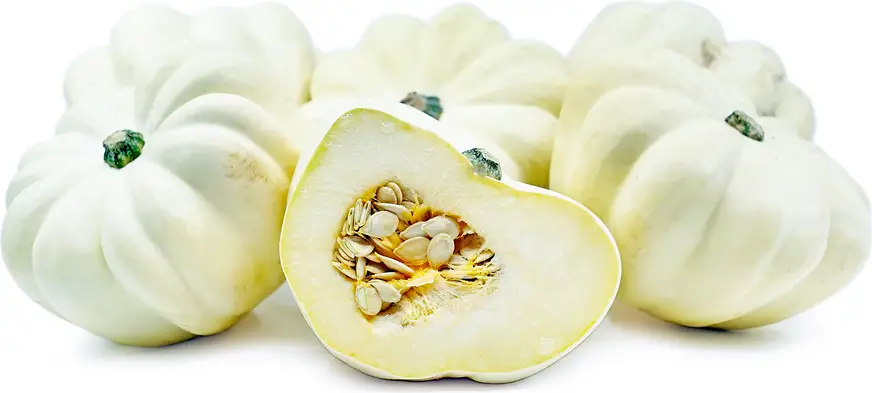What Does White Acorn Squash Taste Like? Does It Taste Good?

When it comes to culinary adventures, our taste buds often seek new horizons, yearning for flavors that surprise and delight. One such flavor quest leads us to the intriguing world of white acorn squash.
White acorn squash, with its distinctive shape and pale skin, is a delightful addition to your culinary repertoire. But what does it taste like? Is it worth adding to your next meal?
In this article, we’ll explore the flavors and culinary potential of white acorn squash, helping you decide whether it’s a taste sensation waiting to be discovered or just another forgettable vegetable.
So, if you want to expand your culinary skills and tantalize your taste buds, let us dive right into the world of white acorn squash, where goodness and taste are waiting to be found.
Introduction to White Acorn Squash
White acorn squash, scientifically known as Cucurbita pepo, is a close relative of the more common green acorn squash. This delightful winter squash variety boasts a unique appearance characterized by its creamy white skin and distinctive ridges that mimic the shape of an acorn. While its visual appeal is undeniable, it’s the taste and culinary potential of white acorn squash that truly pique our interest.
Understanding the taste of white acorn squash is essential for both culinary enthusiasts and health-conscious individuals. Whether you’re planning to incorporate it into your recipes or simply looking for a nutritious addition to your diet, knowing what to expect in terms of flavor is key.
White Acorn Squash Varieties
White acorn squash comes in several distinct varieties, each with its own unique characteristics that influence its taste. Here’s a closer look at some popular white acorn squash varieties:
- Ivory Tower: This variety is known for its ivory-colored skin and boasts sweet, nutty flesh. Its taste is a delightful blend of sweetness and nuttiness, making it a versatile option in various dishes.
- Snowball: With smoother skin than some other varieties, the Snowball white acorn squash offers a mild and slightly sweet flavor. Its subtlety makes it a versatile ingredient in both sweet and savory recipes.
- Polar Bear: The Polar Bear variety stands out with its creamy skin and rich, buttery flesh. When cooked, it becomes exceptionally creamy and indulgent, making it perfect for purees and soups.
- Crystal Cream: Recognizable by its glossy skin, Crystal Cream white acorn squash features tender and delicate flesh. Its subtle flavor allows it to easily absorb the seasonings and flavors of various dishes.
White Acorn Squash Varieties Table
| Variety | Characteristics | Taste |
| Ivory Tower | Ivory-colored skin, sweet and nutty flesh | Sweet and nutty |
| Snowball | Smoother skin, mild and slightly sweet | Mild and sweet |
| Polar Bear | Creamy skin, rich and buttery flesh | Rich and buttery |
| Crystal Cream | Glossy skin, tender and delicate flesh | Tender and delicate |
What Does White Acorn Squash Taste Like?

Now, let’s get to the heart of the matter: the taste of white acorn squash.
1. Delicate and Mild: White acorn squash boasts a delicate and mild flavor profile. Its taste is subtly sweet with a slightly nutty undertone, which distinguishes it from other squash varieties. This mildness allows it to pair well with various ingredients and adapt to different cooking methods.
2. Slightly Nutty: The nutty undertones are more pronounced when the squash is roasted or baked. This quality adds depth and complexity to your dishes, making white acorn squash a versatile and flavorful ingredient.
3. Creamy Texture: Beyond its flavor, white acorn squash offers a creamy texture when cooked. This makes it an excellent choice for purees, soups, and mashes. Its creamy consistency can elevate your recipes, adding a velvety mouthfeel.
4. Versatility: White acorn squash’s mild flavor and creamy texture make it a versatile ingredient that can be used in both sweet and savory dishes. It pairs wonderfully with savory herbs and spices like sage, thyme, and garlic, as well as sweet elements like maple syrup, brown sugar, and cinnamon.
5. Roasting Enhances Flavor: Roasting is one of the best ways to bring out the full potential of white acorn squash’s flavor. When roasted, the sugars in the squash caramelize, intensifying its sweetness and nuttiness. A drizzle of olive oil, some seasoning, and a hot oven can work wonders.
Comparisons to Other Squash Varieties:
Comparing the taste of white acorn squash to other common squash varieties can provide a helpful point of reference:
- Butternut Squash: While butternut squash is sweeter and creamier than white acorn squash, white acorn squash offers a more delicate and nuanced flavor. It’s less overpowering in sweetness, allowing for a wider range of culinary applications.
- Spaghetti Squash: White acorn squash has a smoother and more uniform texture compared to the stringy nature of spaghetti squash. Its taste is also milder and less distinct, making it adaptable to various flavor profiles.
Texture and Aroma Profile of White Acorn Squash
To truly understand what white acorn squash tastes like, let’s embark on a sensory journey:
- Texture: When cooked, white acorn squash boasts a tender and smooth texture. Its flesh is easily scoopable, making it a favorite for purees and soups.
- Aroma: While cooking, white acorn squash emits a subtle, earthy aroma. The scent is mild and inviting, promising a comforting and satisfying dining experience.
Factors Influencing Its Flavor Profile:
Several factors can influence the flavor of white acorn squash, including:
- Variety: As previously mentioned, the variety of white acorn squash you choose will have a significant impact on its taste. Some are sweeter, while others are milder and more subtle.
- Ripeness: The degree of ripeness at harvest affects its sweetness. Fully ripe white acorn squash tends to be sweeter, while raw unripe acorn squash tastes bland.
- Cooking Method: The cooking technique employed can either enhance or mellow the flavor. Roasting, for instance, intensifies its sweetness, while steaming maintains its subtlety.
- Seasonings and Pairings: The choice of seasonings and ingredients used in recipes can greatly influence the overall taste. Spices, herbs, and complementary ingredients can accentuate or balance its flavor.
Nutritional Profile of White Acorn Squash
Beyond its flavor, white acorn squash is renowned for its impressive nutritional profile. It’s a low-calorie, nutrient-rich vegetable that can be a valuable addition to a balanced diet.
Let’s take a closer look at its nutritional content and the health benefits associated with its consumption:
Nutritional Content of White Acorn Squash (per 100g)
- Calories: 40
- Carbohydrates: 10g
- Fiber: 1.5g
- Protein: 1g
- Vitamin A: 40% of the Daily Value (DV)
- Vitamin C: 18% of the DV
- Potassium: 10% of the DV
- Folate: 5% of the DV
White acorn squash is a rich source of vitamins and minerals, particularly vitamin A, which is essential for maintaining healthy vision and a robust immune system. Its high fiber content also helps keep your digestive system healthy, and its low calories make it a good choice for people who are watching how many calories they eat.
Health Benefits Associated with White Acorn Squash:
- Supports Immune Health: Thanks to its high vitamin A and C content, white acorn squash can boost your immune system, helping you ward off illnesses.
- Digestive Health: The fiber inside a white acorn squash aids in digestion and promotes a healthy gut.
- Weight Management: Its low-calorie content makes it a great option for those seeking to maintain or lose weight.
Culinary Uses of White Acorn Squash
White acorn squash’s versatility shines in the kitchen, providing a base for a wide range of food creations. Let’s explore the various cooking methods, recipes, and how different techniques can affect its taste.
Common Cooking Methods for White Acorn Squash
- Roasting: Roasting white acorn squash brings out its natural sweetness and enhances its nutty undertones. The caramelization process during roasting lends a delightful depth of flavor.
- Boiling: Boiling is a straightforward method that preserves the squash’s mild sweetness. It’s a suitable technique when you want to maintain squash’s subtlety.
- Grilling: Grilling white acorn squash imparts a smoky flavor and a slightly crispy texture. This method is ideal for those who enjoy a more pronounced charred taste.
- Steaming: Steaming retains the squash’s tender texture and subtle flavor. It’s a healthier option that preserves its nutritional value.
The cooking technique you choose can significantly influence the taste of white acorn squash. Roasting, for instance, intensifies its sweetness, while grilling imparts smokiness and charred notes. The versatility of white acorn squash means it can adapt to various flavors and culinary styles, making it a valuable ingredient in your kitchen.
| Related: Do You Cook Acorn Squash Up or Down in the Oven? |
Recipes and Dishes Featuring White Acorn Squash
- Stuffed White Acorn Squash: Halved white acorn squash, roasted and stuffed with a savory mixture of grains, vegetables, and herbs.
- White Acorn Squash Soup: Creamy and comforting, this soup combines pureed white acorn squash with aromatic spices and a hint of cream.
- Roasted White Acorn Squash Slices: Simple yet delicious, slices of white acorn squash are roasted with olive oil, herbs, and a touch of maple syrup for a delightful side dish.
- Sausage and Kale Stuffed Acorn Squash:
Pairing White Acorn Squash with Other Ingredients
Pairing white acorn squash with complementary ingredients is an art that can elevate your culinary creations to new heights. The right ingredients can enhance its natural flavors and create a harmonious balance on your plate. Here are some key aspects to consider when pairing white acorn squash with other elements:
Ingredients and Flavors That Complement White Acorn Squash
White acorn squash has a delicate and slightly sweet flavor with nutty undertones. To enhance its taste, consider ingredients and flavors that complement its subtlety:
- Herbs: Fresh herbs like thyme, rosemary, and sage add earthy notes that pair beautifully with the mild sweetness of white acorn squash.
- Spices: Warm spices such as cinnamon, nutmeg, and allspice can enhance the squash’s natural sweetness, making it perfect for sweet dishes.
- Citrus: A squeeze of lemon or a sprinkle of orange zest can provide a refreshing contrast to the squash’s richness.
- Nuts: Toasted nuts like almonds, pecans, or walnuts add a delightful crunch and nutty flavor that complement white acorn squash.
- Cheese: Creamy and savory cheeses like goat cheese, Parmesan, or Gruyère can provide a luxurious and indulgent element when used as toppings or fillings.
Culinary Tips for Enhancing Its Taste in Dishes
Here are some culinary tips to make the most of white acorn squash in your recipes:
- Roasting: Roasting white acorn squash caramelizes its natural sugars, intensifying its sweetness and nuttiness. Drizzle with olive oil, sprinkle with herbs and spices, and roast until tender for a delectable side dish.
- Stuffing: Hollowed-out white acorn squash halves can serve as perfect vessels for flavorful stuffings. Consider a mixture of grains, vegetables, herbs, and protein for a balanced and satisfying dish.
- Pureeing: Blend roasted white acorn squash into a creamy puree. Add a touch of cream, butter, or broth for a velvety texture, and season to taste with your preferred spices and herbs.
| Read: Can I Freeze Acorn Squash Raw With the Skin On? |
Common Myths and Misconceptions About White Acorn Squash
As with many foods, white acorn squash has its fair share of myths and misconceptions surrounding its taste and culinary use. Let’s address some of these misconceptions to provide you with accurate information:
Misconception 1: White Acorn Squash Is Always Sweet
While white acorn squash does have a natural sweetness, it is not overly sweet like some other squash varieties. Its flavor is subtle and balanced, with nutty undertones that make it versatile in both sweet and savory dishes.
Misconception 2: White Acorn Squash Tastes Bland
Some people may perceive white acorn squash as bland if it’s not prepared with the right seasonings and cooking techniques. Its delicate taste requires thoughtful pairing and seasoning to bring out its full potential.
Misconception 3: White Acorn Squash Is Only for Savory Dishes
While white acorn squash is commonly used in savory recipes, it is equally suited for sweet dishes. Its mild sweetness can shine in desserts, such as pies, tarts, and custards.
Misconception 4: White Acorn Squash Has Limited Culinary Use
On the contrary, white acorn squash is highly versatile and can be roasted, pureed, stuffed, or used in a variety of creative ways. Its unique flavor and tender texture make it an excellent addition to your culinary repertoire.
White Acorn Squash in Different Cuisines
White acorn squash’s taste and versatility have made it a star ingredient in various cuisines around the world. Its ability to adapt to different flavor profiles and cooking styles has earned it a place in regional dishes and global favorites. Let’s take a culinary journey to explore its role in different cuisines:
Examining Its Role in Various Global Cuisines
- American Cuisine: In the United States, white acorn squash often appears in classic Thanksgiving dishes. It’s roasted, mashed, or pureed to create side dishes and soups that celebrate the flavors of fall.
- Italian Cuisine: White acorn squash finds its way into Italian cuisine through dishes like “gnocchi di zucca,” a type of gnocchi made with white acorn squash puree, flour, and seasonings.
- Mediterranean Cuisine: The Mediterranean region incorporates white acorn squash in various ways, from roasted squash salads with tahini dressing to stuffed squash with Mediterranean-inspired fillings.
- Indian Cuisine: In India, white acorn squash can be featured in vegetarian curries and stews, where its mild flavor pairs well with a variety of spices and aromatic herbs.
- Mexican Cuisine: Mexican cuisine embraces white acorn squash in dishes like “calabacitas,” a sautéed medley of squash, corn, peppers, and tomatoes seasoned with traditional Mexican spices.
Regional Dishes That Feature White Acorn Squash
- New England: White acorn squash is a staple in New England cuisine, often starring in hearty soups and casseroles, such as “white acorn squash and apple soup.”
- Southern United States: In the South, white acorn squash might be prepared as a sweet and savory side dish with brown sugar and spices, showcasing the region’s love for comforting flavors.
- Middle East: Middle Eastern cuisine incorporates white acorn squash into dishes like “kousa mahshi,” where it’s stuffed with a flavorful mixture of rice, ground meat, and spices.
- Asia: In Asian cuisines, white acorn squash can be found in stir-fries, curries, and tempura dishes, offering a unique twist to traditional recipes.
The adaptability of white acorn squash in diverse cuisines speaks to its versatility and ability to embrace a wide range of flavors and culinary traditions. Whether you’re looking to create a traditional dish or experiment with global flavors, white acorn squash is a versatile ingredient that can take your culinary creations to new heights.
Conclusion: Is White Acorn Squash Worth the Taste?
In conclusion, white acorn squash is a culinary gem waiting to be explored. Its delicate, mildly sweet flavor, combined with a hint of nuttiness, makes it a versatile ingredient for both sweet and savory dishes. Its creamy texture and aesthetic appeal only add to its charm.
Whether you roast it to enhance its nutty notes, create a silky soup, or incorporate it into a variety of recipes, white acorn squash is a delightful addition to your kitchen. So, yes, it’s definitely worth trying, and you may just find it becomes a staple in your culinary repertoire.
Give white acorn squash a chance, and let your taste buds savor this hidden treasure. It’s a testament to how a simple, humble vegetable can bring sophistication and flavor to your table.
So go ahead, embrace the world of white acorn squash, and elevate your culinary experiences with its unique and delectable taste. Your taste buds will thank you.






